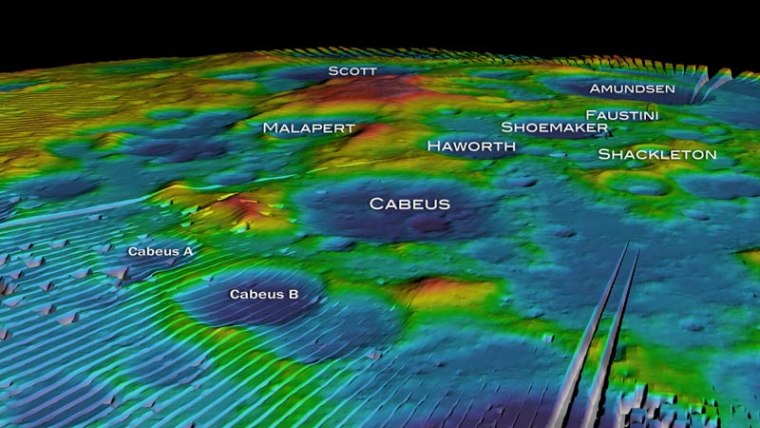A NASA spacecraft destined to crash into a moon crater in the hunt for hidden caches of water ice has a new target, the space agency announced Monday.
The decision means that when NASA's LCROSS probe and its spent Centaur rocket stage slam into the moon on Oct. 9, they will crash into the large crater Cabeus, and not the nearby (and smaller) Cabeus A crater that was previously targeted.
Scientists pulled the lunar switcheroo based on a continuing analysis of data from recent moon-watching spacecraft. The data suggests the new target Cabeus has a concentration of hydrogen — an indication of possible water ice — that's higher than anywhere else at the lunar south pole.
"The LCROSS team concluded that Cabeus provided the best chance for meeting its mission goals," mission managers said in a statement.
The news comes less than a week after scientists announced the discovery of water on the moon in the form of water molecules bound to the lunar dirt.
Cabeus is a large crater about 60 miles (98 kilometers) in diameter that sits at 84.9 degrees south, 35.5 degrees west near the moon's south pole. It has two nearby satellite craters: the 25-mile-wide (40-kilometer-wide) Cabeus A, LCROSS' original target; and Cabeus B, which is about 38 miles (61 kilometers) in diameter.
A small valley etched into the otherwise tall crater ridge of Cabeus should allow sunlight to shine on the ejecta cloud kicked up when LCROSS and its Centaur rocket stage crash into the moon in successive impacts. The shadow of a large hill along the ridge should provide enough contrast for Earth-based measurements of the plume's composition, NASA officials added.
"During the last days of the mission, the LCROSS team will continue to refine the exact point of impact within Cabeus crater to avoid rough spots, and to maximize solar illumination of the debris plume and Earth observations," NASA officials said.
Slideshow 12 photos
Month in Space: January 2014
NASA's LCROSS probe — officially known as the Lunar Crater Observation and Sensing Satellite — is actually a pair of vehicles headed for what maybe one of the most watched cosmic collisions in history.
The $79 million mission was launched in June along with NASA's powerful Lunar Reconnaissance Orbiter as part of the agency's first new missions to explore the moon. Finding usable water ice on the moon would be a boon for future manned missions to the lunar south pole, because that ice could be used as a resource to supply astronauts with drinking water. It could also be split into oxygen and hydrogen to create rocket fuel.
LCROSS and its spent Centaur rocket stage have been making sweeping orbits around the Earth as they fly ever closer to impact day. The Centaur stage will crash into the target first, with LCROSS expected to fly through the resulting debris cloud before meeting its own demise a few minutes later.
Data beamed to Earth from LCROSS during the two impacts, as well as observations from a flotilla of spacecraft and telescopes on Earth and in space, will be recorded to determine whether the two vehicles kick up any water ice among the ejecta from their successive crashes.
LCROSS scientists have dedicated their mission to the memory of the late CBS anchor Walter Cronkite.
More on LCROSS | moon water

